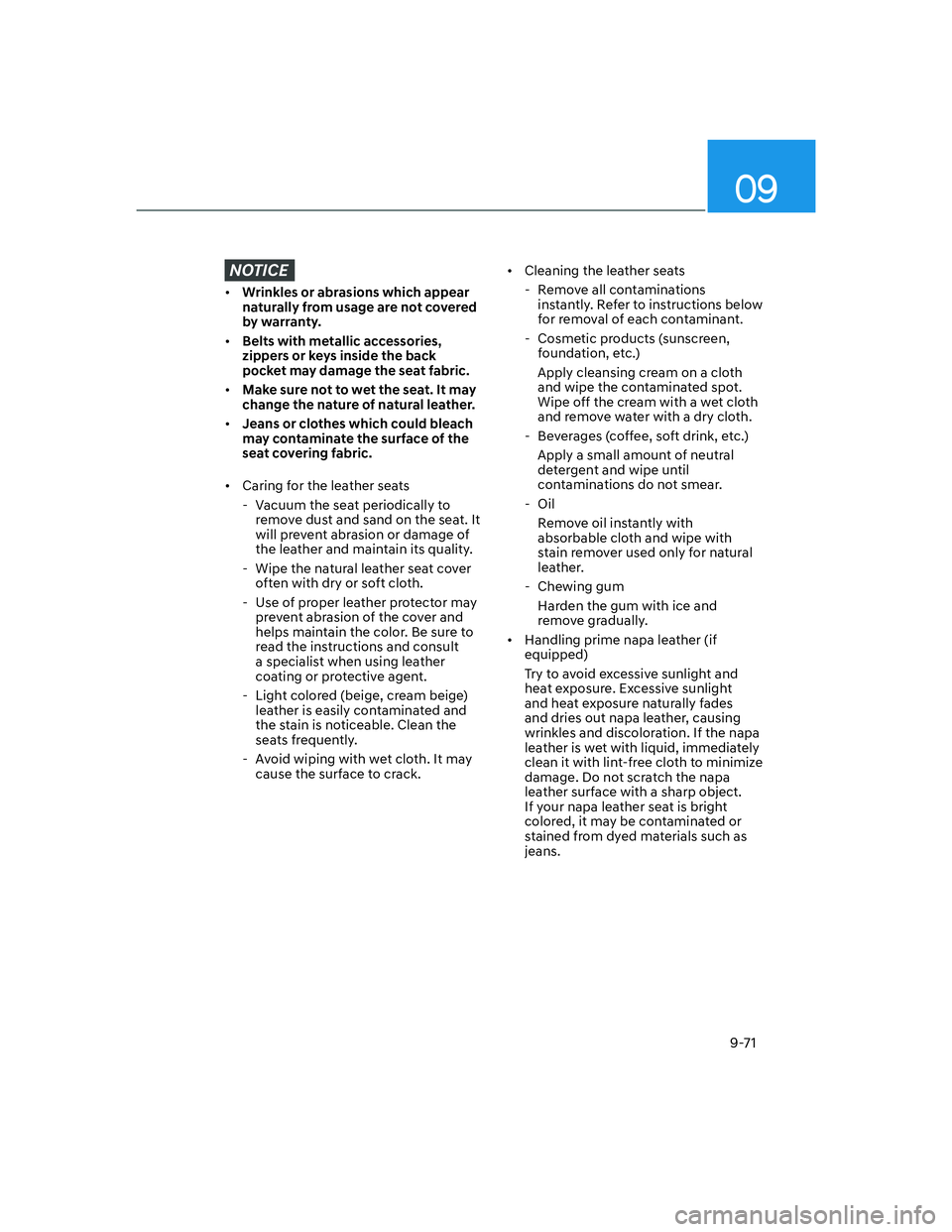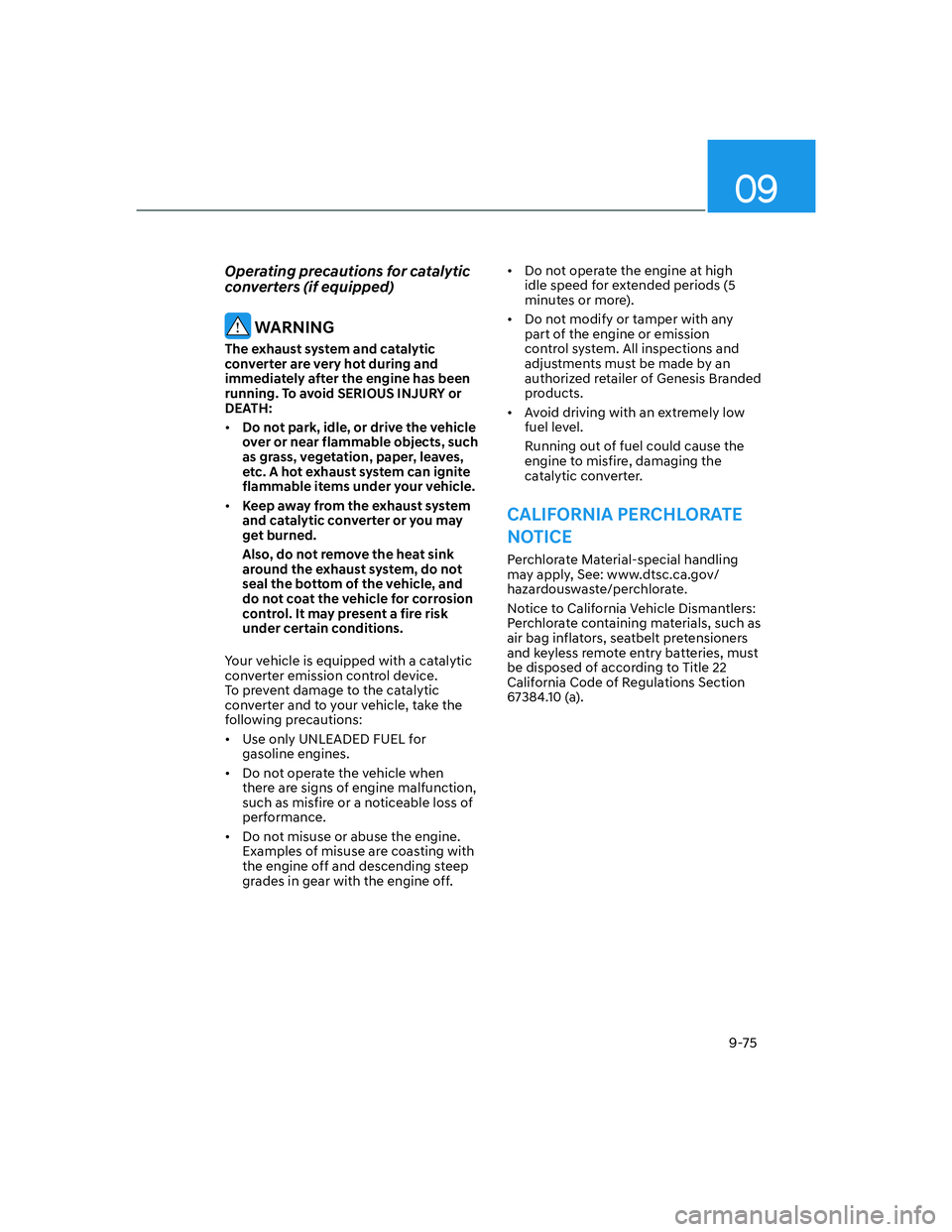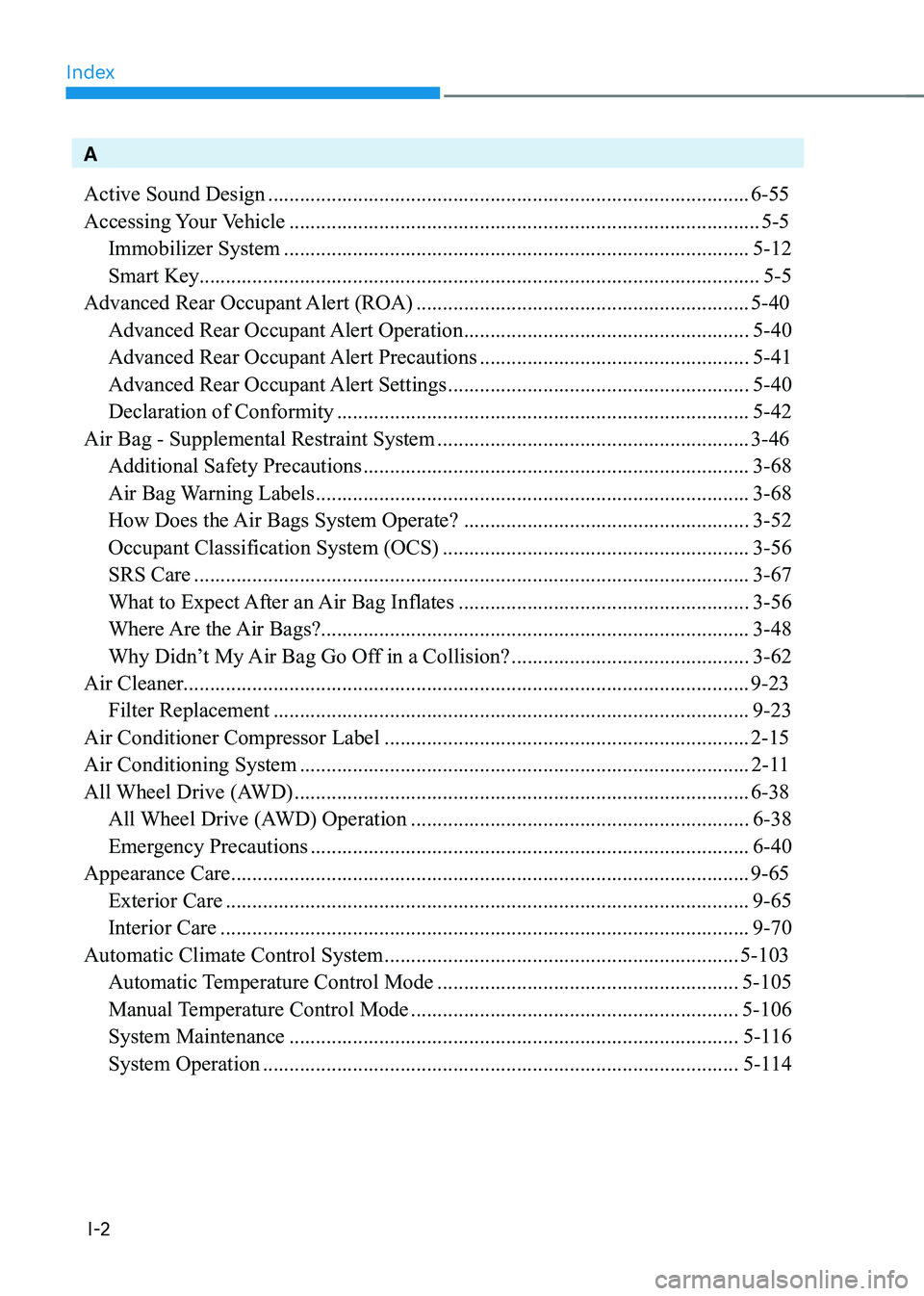2022 HYUNDAI GENESIS GV70 key
[x] Cancel search: keyPage 617 of 647

Maintenance
9-60
Consult an authorized retailer of
Genesis Branded products to replace
most vehicle light bulbs. It is difficult
to replace vehicle light bulbs because
other parts of the vehicle must be
removed before you can get to the bulb.
This is especially true for removing the
headlamp assembly to get to the bulb(s).
Removing/installing the headlamp
assembly can result in damage to the
vehicle.
WARNING
• Prior to working on a light, depress
the foot brake, shift to P (Park), apply
the parking brake, press the Engine
Start/Stop button to the OFF position
and take the key with you when
leaving the vehicle to avoid sudden
movement of the vehicle and to
prevent possible electric shock.
• Be aware the bulbs may be hot and
may burn your fingers.
NOTICE
Be sure to replace the burned-out bulb
with one of the same wattage rating.
Otherwise, it may cause damage to the
fuse or electrical wiring system.
NOTICE
To prevent damage, do not clean the
headlamp lens with chemical solvents
or strong detergents.
Information - Headlamp
desiccant (if equipped)
This vehicle is equipped with desiccant to
reduce fogging inside the headlamp due
to moisture. The desiccant is consumable
and its performance may change based on
the used period or environment. If fogging
inside the headlamp due to moisture
continues for a long time, consult an
authorized retailer of Genesis Branded
products.
Information
The headlamp and tail lamp lenses could
appear frosty if the vehicle is washed after
driving or the vehicle is driven at night in
wet weather. This condition is caused by
temperature difference between the lamp
inside and outside and, it does not indicate
a problem with your vehicle. When
moisture condenses in the lamp, it will be
removed after driving with the headlamp
on. The removable level may differ
depending on lamp size, lamp position
and environmental condition. However, if
moisture is not removed, have the vehicle
inspected by an authorized retailer of
Genesis Branded products.
LIGHT BULBS
Page 628 of 647

09
9-71
NOTICE
• Wrinkles or abrasions which appear
naturally from usage are not covered
by warranty.
• Belts with metallic accessories,
zippers or keys inside the back
pocket may damage the seat fabric.
• Make sure not to wet the seat. It may
change the nature of natural leather.
• Jeans or clothes which could bleach
may contaminate the surface of the
seat covering fabric.
• Caring for the leather seats
- Vacuum the seat periodically to
remove dust and sand on the seat. It
will prevent abrasion or damage of
the leather and maintain its quality.
- Wipe the natural leather seat cover
often with dry or soft cloth.
- Use of proper leather protector may
prevent abrasion of the cover and
helps maintain the color. Be sure to
read the instructions and consult
a specialist when using leather
coating or protective agent.
- Light colored (beige, cream beige)
leather is easily contaminated and
the stain is noticeable. Clean the
seats frequently.
- Avoid wiping with wet cloth. It may
cause the surface to crack.• Cleaning the leather seats
- Remove all contaminations
instantly. Refer to instructions below
for removal of each contaminant.
- Cosmetic products (sunscreen,
foundation, etc.)
Apply cleansing cream on a cloth
and wipe the contaminated spot.
Wipe off the cream with a wet cloth
and remove water with a dry cloth.
- Beverages (coffee, soft drink, etc.)
Apply a small amount of neutral
detergent and wipe until
contaminations do not smear.
- Oil
Remove oil instantly with
absorbable cloth and wipe with
stain remover used only for natural
leather.
- Chewing gum
Harden the gum with ice and
remove gradually.
• Handling prime napa leather (if
equipped)
Try to avoid excessive sunlight and
heat exposure. Excessive sunlight
and heat exposure naturally fades
and dries out napa leather, causing
wrinkles and discoloration. If the napa
leather is wet with liquid, immediately
clean it with lint-free cloth to minimize
damage. Do not scratch the napa
leather surface with a sharp object.
If your napa leather seat is bright
colored, it may be contaminated or
stained from dyed materials such as
jeans.
Page 632 of 647

09
9-75
Operating precautions for catalytic
converters (if equipped)
WARNING
The exhaust system and catalytic
converter are very hot during and
immediately after the engine has been
running. To avoid SERIOUS INJURY or
DEATH:
• Do not park, idle, or drive the vehicle
over or near flammable objects, such
as grass, vegetation, paper, leaves,
etc. A hot exhaust system can ignite
flammable items under your vehicle.
• Keep away from the exhaust system
and catalytic converter or you may
get burned.
Also, do not remove the heat sink
around the exhaust system, do not
seal the bottom of the vehicle, and
do not coat the vehicle for corrosion
control. It may present a fire risk
under certain conditions.
Your vehicle is equipped with a catalytic
converter emission control device.
To prevent damage to the catalytic
converter and to your vehicle, take the
following precautions:
• Use only UNLEADED FUEL for
gasoline engines.
• Do not operate the vehicle when
there are signs of engine malfunction,
such as misfire or a noticeable loss of
performance.
• Do not misuse or abuse the engine.
Examples of misuse are coasting with
the engine off and descending steep
grades in gear with the engine off.• Do not operate the engine at high
idle speed for extended periods (5
minutes or more).
• Do not modify or tamper with any
part of the engine or emission
control system. All inspections and
adjustments must be made by an
authorized retailer of Genesis Branded
products.
• Avoid driving with an extremely low
fuel level.
Running out of fuel could cause the
engine to misfire, damaging the
catalytic converter.
CALIFORNIA PERCHLORATE
NOTICE
Perchlorate Material-special handling
may apply, See: www.dtsc.ca.gov/
hazardouswaste/perchlorate.
Notice to California Vehicle Dismantlers:
Perchlorate containing materials, such as
air bag inflators, seatbelt pretensioners
and keyless remote entry batteries, must
be disposed of according to Title 22
California Code of Regulations Section
67384.10 (a).
Page 634 of 647

Index
I-2
A
Active Sound Design ........................................................................\
...................6-55
Accessing Your Vehicle ........................................................................\
.................5-5
Immobilizer System ........................................................................\
................5-12
Smart Key........................................................................\
..................................5-5
Advanced Rear Occupant Alert (ROA) ...............................................................5-40
Advanced Rear Occupant Alert Operation ......................................................5-40
Advanced Rear Occupant Alert Precautions ...................................................5-41
Advanced Rear Occupant Alert Settings .........................................................5-40
Declaration of Conformity ........................................................................\
......5-42
Air Bag - Supplemental Restraint System ...........................................................3-46
Additional Safety Precautions ........................................................................\
.3-68
Air Bag Warning Labels ........................................................................\
..........3-68
How Does the Air Bags System Operate? ......................................................3-52
Occupant Classification System (OCS) ..........................................................3-56
SRS Care ........................................................................\
.................................3-67
What to Expect After an Air Bag Inflates .......................................................3-56
Where Are the Air Bags?........................................................................\
.........3-48
Why Didn’t My Air Bag Go Off in a Collision? .............................................3-62
Air Cleaner........................................................................\
...................................9-23
Filter Replacement ........................................................................\
..................9-23
Air Conditioner Compressor Label .....................................................................2-15
Air Conditioning System ........................................................................\
.............2-11
All Wheel Drive (AWD) ........................................................................\
..............6-38
All Wheel Drive (AWD) Operation ................................................................6-38
Emergency Precautions ........................................................................\
...........6-40
Appearance Care ........................................................................\
..........................9-65
Exterior Care ........................................................................\
...........................9-65
Interior Care ........................................................................\
............................9-70
Automatic Climate Control System ...................................................................5-103
Automatic Temperature Control Mode .........................................................5-105
Manual Temperature Control Mode ..............................................................5-106
System Maintenance ........................................................................\
.............5-116
System Operation ........................................................................\
..................5-114
Page 639 of 647

I
I -7
G
Genesis Digital Key ........................................................................\
....................5-13
Digital Key (Card Key) ........................................................................\
...........5-20
Digital Key (Smart Phone) ........................................................................\
......5-13
Limitations of the System ........................................................................\
.......5-26
Personalized User Profile and Vehicle Settings ..............................................5-23
Used Vehicle/Digital Key Maintenance ..........................................................5-26
Guide to Genesis Parts ........................................................................\
...................1-3
H
Hazard Warning Flasher ........................................................................\
................8-2
Head-Up Display (HUD) ........................................................................\
.............5-86
Head-Up Display Information........................................................................\
.5-86
Head-Up Display Settings ........................................................................\
.......5-86
Precautions While Using the Head-Up Display ..............................................5-87
High Beam Assist (HBA) ........................................................................\
............5-96
High Beam Assist Malfunction and Limitations .............................................5-97
High Beam Assist Operation ........................................................................\
...5-97
High Beam Assist Settings ........................................................................\
......5-96
Highway Driving Assist (HDA) ........................................................................\
7-109
Highway Driving Assist Malfunction and Limitations .................................7-118
Highway Driving Assist Operation ................................................................7-111
Highway Driving Assist Settings ..................................................................7-110
I
Idle Stop and Go (ISG) ........................................................................\
................6-47
Forced to Restart Engine ........................................................................\
.........6-50
ISG Malfunction........................................................................\
......................6-50
ISG System Off ........................................................................\
......................6-49
ISG System Operation........................................................................\
.............6-47
If the Engine Overheats ........................................................................\
.................8-7
If the Engine Will Not Start ........................................................................\
...........8-3
If You Have a Flat Tire (With Spare Tire) ...........................................................8-13
Changing Tires ........................................................................\
........................8-14
Jack and Tools ........................................................................\
.........................8-13
Jack Label........................................................................\
................................8-19